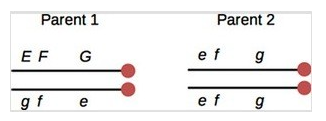In plants, genes E, F, and G are on one chromosome arm. Alternate dominant and recessive alleles of all three genes determine visible traits: E = normal leaf number, e = extra leaves, F = normal stems, f = furry stems, G = normal flower size, g = gigantic flowers. A plant that is heterozygous for an inversion involving all three genes is crossed to a plant with extra leaves, furry stems, and gigantic flowers. The arrangement of alleles is shown in the diagram. If you look at thousands of offspring of this cross, what phenotypes do you expect to see?(Select all that apply.)

A) Most, but not all, offspring will be normal for all three traits or have extra leaves, furry stems, and gigantic flowers.
B) Due to double crossovers between E and F and F and G, a very small number of offspring will have only furry stems, or only extra leaves and gigantic flowers.
C) Half of the offspring will be normal for all three traits and half will have extra leaves, furry stems, and gigantic flowers.
D) Due to crossovers between E and F in parent 1, a small number of offspring will have only extra leaves, or only furry stems and gigantic flower size.
E) Due to crossovers between F and G, a small number of offspring will have only extra leaves and furry stems, or only gigantic flower size.
A) Most, but not all, offspring will be normal for all three traits or have extra leaves, furry stems, and gigantic flowers.
B) Due to double crossovers between E and F and F and G, a very small number of offspring will have only furry stems, or only extra leaves and gigantic flowers.
You might also like to view...
Choanoflagellates _____
A) are usually parasitic B) are motile as adults C) live in aquatic habitats D) are animals
It is thought that the oldest stage of cellular respiration from an evolutionary perspective is
A. the krebs cycle. B. the electron transport chain. C. fermentation. D. glycolysis.
Cyclic dimeric guanosine monophosphate (c-di-GMP) serves as a messenger molecule in bacterial cells to coordinate a shift from ________ to ________ growth
A) sessile / planktonic B) planktonic / sessile C) monomorphic / polymorphic D) stationary / exponential
Evolution _____
a. is natural selection b. is heritable change in a line of descent c. can occur by natural selection d. is heritable change in a line of descent and can occur by natural selection